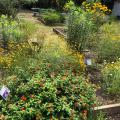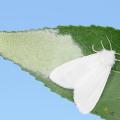Spider Mites
Spider mites are tiny, eight-legged arthropods that attack many ornamental and vegetable plants. There are several species of spider mites, but twospotted spider mite is by far the most common. Although spider mites prefer to feed on the undersides of leaves, damage is usually visible on the tops of leaves, which initially have a stippled appearance. Heavily damaged leaves often have a bronzed appearance or may be dead and brown. Low populations are rarely damaging, but heavy infestations can cause serious damage and even kill entire plants. Spider mite outbreaks are more likely to occur during hot dry weather or under dusty conditions. Webbing is usually present on heavily infested plants. Spider mites are often naturally controlled by predatory mites and naturally-occurring diseases, but unnecessary insecticide sprays can trigger outbreaks by disrupting this natural control. For example, plants that are exposed to sprays from mosquito misting systems or from municipal mosquito treatment trucks are more likely to experience mite infestations.
Control Spider Mites: There are no good spider mite treatments readily available to home gardeners! Avoid unnecessary insecticide treatments as these can trigger mite outbreaks—don’t spray other plants in the landscape just because you have to spray the azaleas for lace bugs. Treatments such as horticultural oils, neem oil, or insecticidal soaps will control spider mites, but it takes thorough spray coverage, especially to undersides of leaves, and repeated sprays, and there is a risk of spray-induced plant injury. These treatments are most useful on smaller plants but are difficult to use effectively on larger plants or on large scale plantings. Fortunately, spider mite outbreaks are rarely fatal to established older plants, and will usually “run their course” even if you do nothing other than keep the plants well-watered. Spider mite outbreaks can sometimes be deterred by washing foliage with a forceful water spray once per day. For serious mite problems on high-value plants, consider hiring a licensed commercial applicator. These professionals have access to effective miticides.
See Insect Pests of ornamental plants in the home landscape, page 13 and pages 39-41 for more information on spider mites.
Publications
News
A grant from Coast Electric will allow for a renovation of the Mississippi State University Crosby Arboretum’s pollinator garden. Pat Drackett, director of the arboretum, said the pollinator garden was established in 2001 as the Explorers’ Garden. It is a 3,000-square-foot space with a variety of native and other plants that helps teach visitors how to create havens for pollinators.
The 2020 Fall Flower & Garden Fest will be a virtual, educational event this year.
A tent for camping in the woods can be a good thing, but a tent filled with caterpillars in a pecan tree can be bad news for homeowners.



